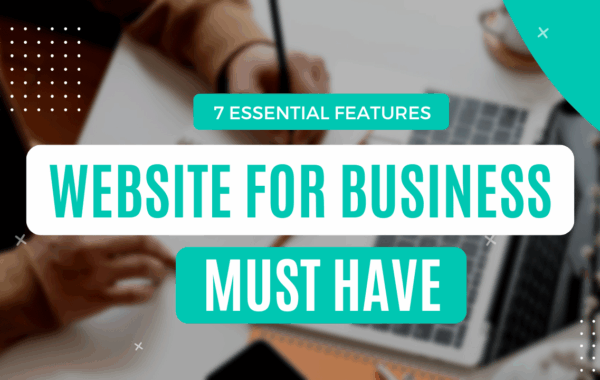How to create a website for your business
Creating a website for your business is a crucial step in today’s digital age. It’s not just about having an online presence. It’s about building a platform that reflects your brand and attracts customers.
Many small business owners feel overwhelmed by the process. They worry about the technical skills needed. But building a website is more accessible than ever.
With the right guidance, you can create a site that meets your business goals. Whether you’re a marketing manager, a business owner, or a consultant, a well-designed website can transform your business.
A website can turn visitors into leads and leads into customers. It can showcase your products or services and build trust with your audience.
In this guide, we’ll walk you through the steps to build a successful business website. From choosing a domain name to optimizing for SEO, we’ve got you covered. Let’s get started on your journey to a powerful online presence.
Why Every Small Business Needs a Website
In today’s digital marketplace, a website acts as a virtual storefront. Without it, your business might be invisible to potential customers. People look online first for products and services, making your online presence vital.
A website does more than just present information. It builds credibility. Even small businesses gain trust by appearing professional. Visitors expect to find you online.
Your website is a 24/7 sales tool. It can showcase your services, offer customer testimonials, and highlight your expertise. This powerful tool works even when you’re not.
Consider these key benefits of having a business website:
- Reach a wider audience
- Establish credibility and authority
- Provide round-the-clock accessibility
In sum, being without a website means lost opportunities. Develop a strong online presence to connect with potential clients and grow your business.
Step 1: Define Your Website’s Purpose and Goals
Before diving into design and content, clarify your website’s purpose. This foundational step ensures alignment with your business objectives. Is your site meant to generate leads, sell products, or provide information?
Knowing your goals informs every decision you make. It affects layout, features, and even color schemes. Tailor your website to meet these specific aims, paving the way for success.
Consider what you want visitors to do once they land on your site. Should they subscribe, fill out a form, or make a purchase? Identifying these actions sharpens your focus.
Here are key questions to consider:
- What is the primary function of your site?
- Who is your target audience?
- What actions do you want visitors to take?
Once you have clear answers, you’ll create a more effective website. Defining purpose and goals guides your choices, turning visitors into engaged customers.
Step 2: Choose and Register a Domain Name
A memorable domain name is vital for your business website. It’s your online address, making it easier for customers to find you. Choose wisely; your domain is part of your brand identity.
First, aim for simplicity and relevance. A short, catchy name is easier to remember and type. Avoid using complex words or unusual spellings that might confuse potential visitors.
Next, consider keyword inclusion. If possible, incorporate a relevant keyword that describes your business or industry. This can improve your search engine ranking and make your site easier to find.
Don’t forget to check for availability. Use a domain registration service to see if your chosen name is up for grabs. Many businesses find that their first choice is already taken, so have alternatives ready.
Here’s a quick checklist for selecting your domain name:
- Easy to spell and pronounce
- Reflects your brand or business
- Includes relevant keywords
Once you settle on a domain, register it through a reliable registrar. Locking it in early prevents others from taking it. It’s a crucial step that reinforces your online presence.
Step 3: Select the Right Website Platform or Builder
Choosing the right platform is foundational for your small business website. Consider your skills, budget, and goals. Each platform offers unique advantages, influencing your site’s functionality and management.
Website builders like Wix, Squarespace, and Shopify offer user-friendly interfaces. They’re ideal for beginners needing quick setup without coding knowledge. However, customization can be limited.
In contrast, WordPress.org provides immense flexibility and control. It’s perfect for those seeking custom functionality and design. Yet, it requires more technical know-how compared to website builders.
E-commerce businesses might explore platforms like Shopify, tailored for online stores. They provide integrated features like payment gateways and inventory management, easing online transactions and operations.
Evaluate your specific business needs by considering:
- Budget constraints
- Technical expertise
- Need for custom features
Here’s what you should look into when exploring different platforms:
- User-friendly interface
- Support options available
- Customization capabilities
Your platform affects your website’s future scalability and management. Research and test potential options using free trials before committing.
Comparing Website Builders vs. WordPress vs. Hiring a Pro
Different paths suit different needs in web development. Website builders offer simplicity and all-in-one solutions. They are ideal for those looking for quick launches with minimal tech hassle.
WordPress is suited for those who want full customization. Its flexibility is unmatched but comes with a steeper learning curve. This option suits those with time to invest or who plan to hire help.
Hiring a professional designer brings expertise to complex projects. It’s the best choice when custom, high-level design and functionality are needed, though often more costly.
Consider the following to determine the best route for you:
- Budget: Assess initial and ongoing costs.
- Time: Consider how much time you can spend on building and maintaining.
- Technical Skills: Evaluate your comfort with tech and coding.
Whether a simple builder or a custom-built site, choose the right path for your business’s unique needs.
Step 4: Plan Your Website Structure and Core Pages
Effective website planning begins with understanding your audience. Consider what visitors need and expect when navigating your site. This will guide your website’s structure.
Start with a simple site map to outline core pages. Common pages include:
- Home: The welcome mat of your digital space.
- About: Share your story and values.
- Services/Products: Detail what you offer.
- Contact: Make reaching out easy.
For e-commerce, additional pages like “Shop” and “FAQ” might be necessary. These ensure visitors can easily find what they’re looking for.
Craft clear navigation paths. Keep them intuitive to prevent users from feeling lost. Focus on creating a seamless journey that highlights key information.
Remember, each page should serve a specific purpose. Avoid cluttering pages with unnecessary details. Instead, maintain a clean, focused layout that directs attention where it’s needed.
Reflect on your business goals and prioritize the pages that align with those. Proper planning at this stage ensures a strong foundation for your online presence.
Step 5: Design Your Website for Trust and Conversion
A captivating design immediately makes a positive impression. It’s crucial for building visitor trust. First, ensure your design aligns with your brand’s identity. Consistency in color schemes, fonts, and imagery strengthens brand recognition.
Focus on a clean and professional look. Avoid clutter by using ample white space, which makes content easier to digest. Remember, simplicity often leads to elegance.
Prioritize a user-friendly experience. Intuitive navigation means users can find what they need quickly. Place essential information like contact details and calls-to-action prominently.
Consider incorporating trust signals throughout the site. These might include:
- Testimonials
- Customer reviews
These elements enhance credibility, assuring visitors of your business’s reliability.
Additionally, incorporate features that drive conversions. These could be:
- Compelling CTAs: Encourage specific actions like signing up or making purchases.
- Interactive elements: Engage users, increasing time spent on the site.
Visuals also play a vital role. Use high-quality images and graphics to draw attention and convey professionalism. An image of a well-designed website can serve as an inspiration.
Implementing these design principles can transform your site into a tool that not only attracts visitors but converts them into customers.
Step 6: Add Compelling Content and Visuals
Content is the heart of your website. It shapes how visitors perceive your business. Start by identifying your audience’s needs and tailor content to meet them.
High-quality content is not just about words. Combine clear, concise text with eye-catching visuals. This combination makes information more digestible and engaging.
Use content to tell your brand’s story. Highlight what sets you apart from competitors. Authentic stories resonate with audiences and build lasting connections.
Visuals enhance content, providing depth and interest. Include:
- Infographics
- Illustrations
- Images of your products or services
Each should support and enrich your message. Pair strong visuals with a strategic use of color and style for maximum impact.
An engaging website speaks to visitors, pulling them in and guiding them through your brand narrative. Think of visuals as another way to communicate.
Creating a cohesive blend of text and imagery will not only keep visitors on your site longer but will also deepen their connection to your brand.
Step 7: Optimize for Mobile and SEO
In today’s digital landscape, mobile optimization is crucial. Many users access websites through their mobile devices. Your site must be mobile-friendly to retain potential customers.
Begin by ensuring your design is responsive. A responsive design adjusts seamlessly to various screen sizes. This provides an enjoyable user experience across all devices.
Search Engine Optimization (SEO) goes hand in hand with user experience. You want to make sure potential clients can easily find your site. Use relevant keywords naturally in your content and meta descriptions.
Optimize your site’s load speed for both mobile and desktop. Fast load times improve user experience and boost search engine rankings. Focus on the following:
- Compress images
- Minimize redirects
- Enable browser caching
By optimizing for mobile and SEO, you elevate your site’s visibility and usability. This strategic approach attracts more visitors, growing your audience and client base.
Step 8: Set Up Lead Capture and Contact Features
To transform visitors into potential clients, integrating lead capture tools is key. Begin by incorporating forms that collect basic visitor information like email addresses. This is your direct line to future interactions.
Keep your forms short and simple. Long forms discourage users from completing them. Instead, focus on getting just enough information to follow up effectively.
Additionally, make sure your contact information is easy to find. This could be through a dedicated contact page or a sticky footer with details like:
- Business email
- Phone number
- Physical address
By setting up effective lead capture and contact features, you create a direct route for audience engagement. This builds a stronger relationship with potential clients and increases conversion rates.
Step 9: Test, Launch, and Monitor Your Website
Before launching, ensure everything works perfectly. Conduct thorough tests across different devices and browsers. This ensures compatibility and a seamless user experience.
Pay attention to elements such as:
- Navigation flow
- Form submissions
- Responsive design
Once satisfied, it’s time to go live. Announce your website to your audience through social media or email.
After launching, continuous monitoring is crucial. Use analytics tools to track visitor behavior and website performance. Regularly check your site’s speed and fix any issues promptly. This helps maintain a positive user experience and optimizes your site for conversions.
Employ these practices to keep your website fresh and engaging.
Step 10: Promote Your Website and Grow Your Audience
You’ve launched your website, but the journey doesn’t stop there. Now, it’s time to let the world know about it. Promotion is key to attracting visitors and building your customer base.
Utilize these strategies to enhance visibility:
- Social media marketing
- Email newsletters
- Collaboration with influencers
by Shutter Speed (https://unsplash.com/@shutter_speed_)
Engage with your audience through social media platforms. Share valuable content and start conversations to build a community around your brand.
Additionally, establish an email list. Offer a valuable incentive in exchange for subscriptions. Regularly update your subscribers with news and offers to keep them engaged and returning.
Collaborate with influencers in your industry to reach broader audiences. Their endorsement can significantly boost your website’s visibility, establishing credibility and attracting new visitors.
Common Mistakes to Avoid When Building a Small Business Website
Building a website involves many moving parts. In the rush to launch, it’s easy to overlook critical elements. Avoiding common pitfalls can save time and resources.
Consider these mistakes that can hinder your site’s success:
- Ignoring mobile optimization
- Overloading pages with information
- Neglecting SEO
Mobile optimization is crucial. Many users access websites from their phones. Ensure your site performs seamlessly on all devices.
Another pitfall is overwhelming your visitors with content. Keep messages clear, concise, and focused on user needs. Lastly, do not ignore SEO practices. This will enhance your site’s visibility, bringing in organic traffic and potential customers.
Final Thoughts: Your Website as a Growth Engine
Your website is more than an online business card; it’s a powerful tool for growth. A well-crafted site not only attracts visitors but converts them into loyal customers. Each element should work towards establishing trust and driving engagement.
By focusing on user experience and strategic content, your website can become a catalyst for success. Remember, it’s a dynamic asset that evolves with your business. Regular updates and improvements will ensure it continues to be an engine for growth.


